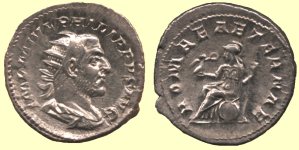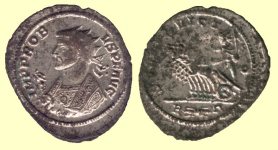

The Golden Age of Rome was from 98-190 AD. Rome was the largest it would ever be. It lost no wars, paid no tribute and the Mediterranean was a Roman lake. During that time at least 20 million people lived within the borders of the Roman Empire. In most areas every day commerce was conducted with the sestertius (a large bronze coin about 30mm in diameter) and its fractions. For a sestertius you could get three glasses of wine and a loaf of bread. Many commercial transactions were conducted in sestertii (the plural), even the sale of the Roman Empire itself. The sestertii weighed an average of 28 grams and bore portraits of the emperor and his family as they wanted to be seen by the people of Rome.
The most commonly found coin from the second century BC through the first half of the third century AD is the silver denarius. This popular coin is usually between 18 and 20 millimeters across, and weighs between 3 and 4 grams. A denarius was equivalent to four sestertii in the Roman accounting system.
The gold aureus was the most valuable denomination from its inception in 83 BC through the time of Constantine in the early part of the fourth century AD when it was replaced by the gold solidus. The aureus was valued at 100 sestertii, or 25 denarii, it is about the same size as a denarius, but weighs about twice as much.
The bronze As was a good sized brass or copper coin, about 23 to 30 mm across, and weighing 8 to 12 grams. Worth one-quarter of a sesterius, it was a commonly used coin among the Roman public. It was also the unit of account, until the denarius took over that role in the second century BC.
1 gold aureus = 2 gold quinarii = 25 silver denarii = 50 silver quinarii =100 bronze sestertii = 200 bronze dupondii = 400 bronze asses
1 gold quinarius = 50 bronze sestertii, etc.
1 silver denarius = 2 silver quinarii = 4 bronze sestertii = 8 bronze dupondii = 16 bronze asses
1 silver quinarius = 2 bronze sestertii, etc.
1 bronze sestertius = 2 bronze dupondii = 4 bronze asses
1 bronze dupondius = 2 bronze asses
1 bronze as = 2 bronze semisses
Follow this link to a great article about what a roman coin was worth and what it would buy.
Antoninianus is the modern name for the silver coin introduced by the Emperor Caracalla in 215 AD to supplement the debased denarius. Its ancient name is not known, so it has been named after Caracalla's proper name (Marcus Aurelius Antoninus) it can be identified by the radiate crown on the obverse portrait. It is not really known what the legal ratio of antoniniani to denarii was but it is believed to have been issued as a double denarius, although it was only 1.5 times the weight of a denarius. This was a common method of devaluation throughout history. Its typical diameter was approximately 22-23 millimeters. The antoninianus began its existence as a silver coin and was later debased to a copper coin with a silver wash. It was eventually discontinued by Constantine.

